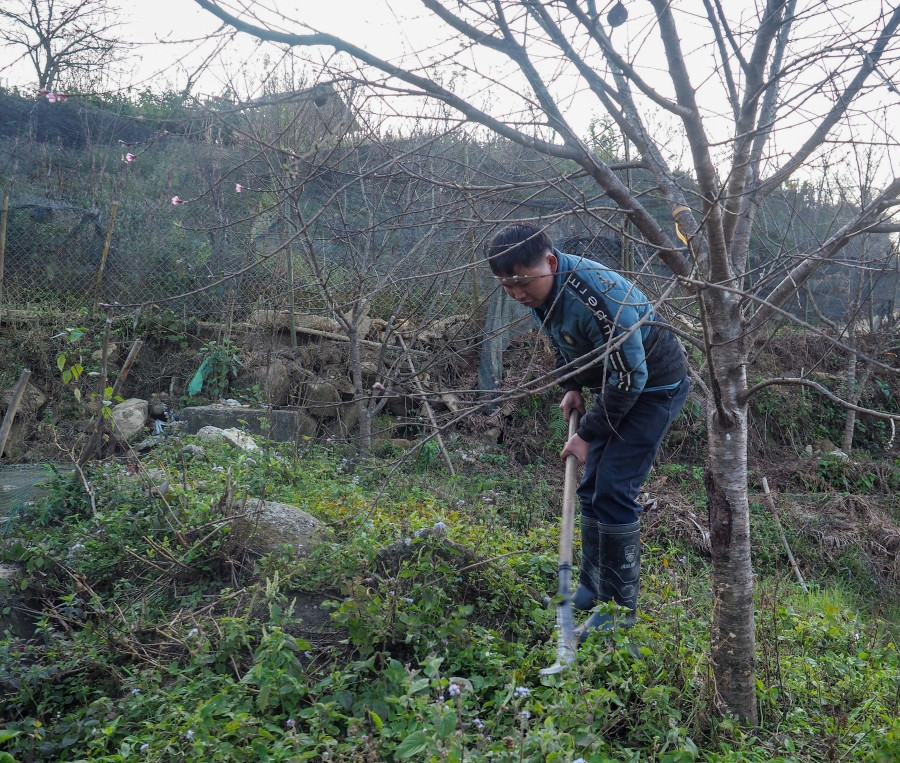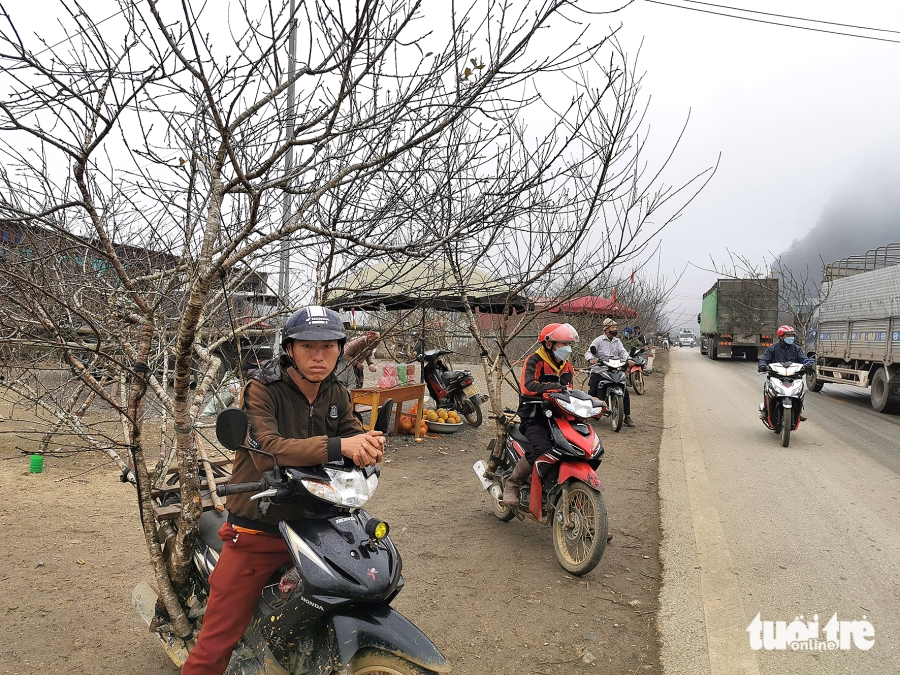The rough and varied "wild peach" branches brought from the mountains to Hanoi are being sold for millions of dong, even hundreds of millions of dong per branch. Where do they come from? Are the peach trees actually cut down in the forest?

Mr. Chau A Sau, Trung Chai commune (Sa Pa, Lao Cai) earns nearly one hundred million VND/year from growing peaches on the fields.
Many people are calling for not buying this type of "wild peach" to protect the environment. Go against the flow of wild peach branches coming from the Northwest to find the truth.
Wild peaches at the mountain peach market
Following the route where traders bring peach blossoms downstream, we headed up National Highway 6. In the days leading up to Tet, many sections here are congested because people gather to market peach blossoms. In places like Loong Luong commune, Van Ho, Moc Chau Farm town, Ta Lang intersection, Co Noi (Son La province) or Pha Din pass, Tuan Giao intersection (Dien Bien)... these days, peach blossoms are everywhere. Peach blossoms come in all shapes and sizes, from small bundles like chopsticks to peach trunks as big as thermoses, their canopies covering an entire yard.
The peach branches of the people in the highlands do not have as many flowers as those in the lowlands, nor are they carefully shaped, but are rustic and rough. "People in the lowlands are very strange! The peach branches do not grow flowers, but are covered in moss, but "they" (customers) buy them for 3 million VND", Giang A Phu, Bo Nham village, Van Ho (Son La), shared.
A Phu boasted that his family had several fields. The fields with lots of rocks, if corn doesn't bear fruit, then plant peaches. The fields with the most are 200 trees, the fields with the least are a few dozen. On bad, bare land, turn over the rocks, bury the peaches, feed the plants with a little fertilizer, and after a few years you'll have millions.
"This year, I sold 50 million worth of peach trees! My family has peach trees for the fruit, peach branches for sale, and peach trees for the roots. During Tet, I sold peach trees to people in the lowlands and was able to buy a fat buffalo," A Phu boasted.
In Van Ho district (Son La) alone, there are about 500 hectares of native peach trees. The actual peach area is larger because people grow them on the edge of fields, mountainsides, forest edges or vacant land that is not fully counted. Of this, more than half is peach growing area for flowers and branches to serve the people's Tet needs.
Mr. Thai Ba Sinh, Head of the Department of Agriculture and Rural Development of Van Ho district (Son La province) said that peach trees have been planted by local people for several decades. Initially, people planted peach trees following the State's policy of introducing this tree variety to create a livelihood for people after destroying opium poppies.
Peach trees in Moc Chau and Van Ho were previously grown mainly for their fruit. Later, the economic value of peach trees for Tet branches was higher, so people switched to growing peach trees to sell during Tet.
"Peach trees are very suitable for the soil conditions in Van Ho. People only need to plant them for three years before they can start harvesting. What's special is that peach fields are not well cared for. Drizzle, frost, and high humidity cause moss and lichen to stick to the tree trunks, making them even more valuable. Growing and harvesting peaches for flowers each year gives people in Van Ho district many times more income than growing corn or cassava," said Mr. Sinh.

Peach trees for sale along Highway 6 (Son La)
"Wild peach" is not in the forest
The native peach trees of the northern mountainous region have suffered much "unfair" criticism because they are called "wild peaches". However, according to a survey by professional agencies in the provinces with the most peach trees, Son La, Dien Bien, Lai Chau, Lao Cai, Yen Bai..., there are no wild peach trees growing in natural forests. Most native peach trees are planted by people on fields, forest edges or in some cases grow near roads because people leave seeds behind.
Mr. Nguyen Huu Hanh, Director of Hoang Lien National Park (Sa Pa, Lao Cai) said that peach trees are light-loving plants and have difficulty competing in natural forests. Many forestry research documents state that peach trees originate from forests in the Hoang Lien Son range, but in reality they are very rare.
"Peach trees are planted by people in gardens on mountain slopes or along fields, forest edges, near roads... places that have been cleared and have a lot of light. If peach trees grow in natural forests, it will be very difficult to compete. They will only grow for the first few years, when other trees and vines take up the light, the peach trees will not grow and die," Mr. Hanh explained why it is difficult to grow wild peach trees in natural forests.
Two years ago, when other localities tried to stamp and issue certificates for people to harvest peach branches during Tet, the leader of the Department of Agriculture and Rural Development of Lao Cai province affirmed that there were no wild peach trees in Lao Cai, so people did not have to stamp or apply for certificates for peach trees.
National parks provide seeds
The director of Hoang Lien National Park said that Sa Pa has very special climate and weather conditions. The heavy fog causes moss and lichen to grow on peach tree trunks, allowing peach branches in this area to both bloom and grow.
"Each beautiful peach branch can be sold for millions of dong, many households earn hundreds of millions during Tet. The general policy of Sa Pa town and the national park is to encourage people to grow peach trees to increase their income. Hoang Lien National Park provides seeds and guides people in planting and caring for them. As for wild peach trees (thick peach trees, cherry blossoms) in the natural forest, the staff of the garden strictly protects them," Mr. Hanh affirmed.
Mr. Mac Van Tai (in Thuy Nguyen, Hai Phong) - a long-time wild peach trader - said that Hai Phong is the place with the most "wild" peach traders in the North. Two months before Tet, traders went to all over the North such as Sa Pa (Lao Cai), Tram Tau (Yen Bai) or Son La, Dien Bien, Lai Chau to "catch" peaches.
"Every year, I transport about a dozen trucks downstream. Small branches are sold in Hanoi, large, beautiful branches are sent to Hai Phong, and medium-sized branches with shapes like "fortune", "three gods", "father and son", "bat phong" are sent to Thanh Hoa and Nghe An. When going downstream, we just call them "forest" peach trees to easily distinguish them from bonsai and branch peach trees in the lowlands," said Mr. Tai.
No need to stamp because it is no longer dug in the forest. In recent years, Van Ho district has had to print origin traceability labels for peach branches to distinguish between peaches harvested in home gardens and natural peaches. However, according to the head of the Department of Agriculture and Rural Development of Van Ho district, through a survey in Van Ho, there are no peaches growing in natural forests. The labeling is only to create more favorable conditions for people when buying, selling, and transporting... In 2022, the district stopped affixing origin traceability labels to peach branches because it was unnecessary. |
According to Tuoi Tre